|
The Sausage Saga, part 5:
Klobasse, klobása, kielbasa, kolbász:
Austrian, Czech, Hungarian and Polish sausages.
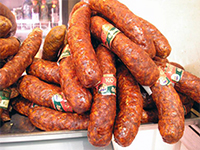
Hungarian kolbász. |
The wurst situation in the countries of the former Austro-Hungarian Empire is quite different from Germany.
Traditional sausages from Austria, Czech Republic, Hungary, Poland, Slovakia, Slovenia etc.,
in general, are quite different, reflecting the completely different histories.
The cuisine in these countries evolved from the Austro-Hungarian empire,
which until WWI was the largest country in Europe, larger than Germany, France and Britain.
The country was extremely diverse, consisting of present-day Austria, Bosnia and Herzegovina, Croatia,
Czech Republic, Hungary, northern part of Italy, Montenegro, Poland, Romania, Serbia, Slovakia, Slovenia, Ukraine.
More than 10 languages were spoken: German and Hungarian were the official ones, but also Czech, Polish,
Ukrainian, Romanian, Croatian, Italian, Serbian, Slovak, Slovene, Bosnian, Rusyn, and Yiddish.
The Austrian, and later the Austro-Hungarian empire, had existed in one form or another for 300 years since 1618 until 1918.
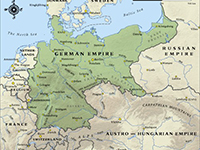
German Empire in 1914. |
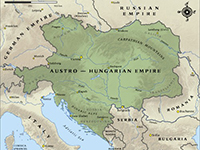
Austro-Hungarian Empire in 1914. |
Germany had been an assemblage of independent kingdoms, grand duchies, duchies, principalities,
free Hanseatic cities throughout the Middle Ages and the Renaissance, until the 19th century.
Although the vast majority of these people spoke German (over 50 million at the time of unification),
there were a number of other languages spoken: Polish, French, Danish, Lithuanian...
The Kingdom of Prussia was by far the largest one, covering over 60% of the territory,
followed by the Kingdom of Bavaria, Württemberg and Saxony. A number of smaller Duchies and Principalities followed.
It is important to realize that the map of Europe looked at little different
in the middle of the 19th century. Poland did not exist; most of it
belonged to the Prussian Kingdom (Preussen), the rest to the
Austro-Hungarian Empire and to the Russian Empire.
The eastern part of France (Alsace) was German. The Czech Republic, Slovakia and Hungary
belonged to the Austro-Hungarian Empire, as did parts of Italy
(South Tirol and the area areound the city of Trieste, known as Friuli-Venezia Giulia),
plus Slovenia, Croatia, Bosnia-Herzegovina, Ukraine, and parts of Romania (Transylvania).
In 1871, this motley assemblage was unified under one roof by Otto von Bismarck
(Otto Eduard Leopold, Prince of Bismarck, Duke of Lauenburg, to be precise),
and became known as the German Empire with a capital in Berlin.
However, eventhough it was now one country, Germany was still a mix
of very different cultures. The main lines ran between the traditionally
protestant north and the catholic south.
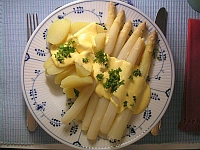 | 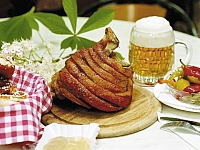 |
Asparagus with hollandaise sauce
from the north. | Roasted pork knee from Bavaria. |
German cuisine reflects these regional differences.
Traditional dishes from the southern part of Germany are very different from
those in the northern parts of Germany.
The dividing line runs somewhere between the former kingdoms and duchies
of Prussia, Saxony and Pfalz to the north, and Thuringia, Franconia, Bavaria,
Baden and Württemberg to the south. These regional differences
are not limited to Germany itself, but transcend the borders of the two
big former empires. For example, Czech cuisine is very similar
to Bavarian cuisine to the west, rather than to food from the former
Kingdoms of Saxony and Prussia to the north.
Specific examples of Southern-German / Czech cross-pollination include
certain types of sausage, such as the Czech and Franconian white-wine sausages,
roasted pork with sauerkraut and dumplings
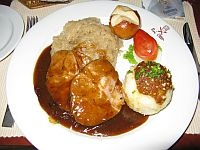 | 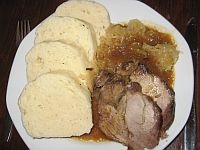 |
| Schweinebraten from southern Germany. | Czech pork roast, dumplings and sauerkraut. |
Cross-pollination, however, did curiously not take place in the
area of sausage. With the exception of the white-wine sausages,
Thuringian, Franconian and Bavarian bratwursts did not make it into
the world of Czech wurst. Czech sausages are dominated by somewhat fatty klobása,
smoked pork Brühwurst more similar to Polish and Hungarian sausages.
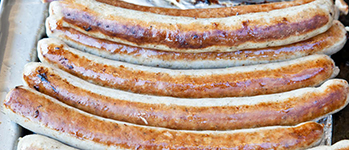 | 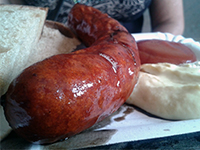 |
| German bratwurst from Bavaria. | Czech klobása. |
Interesting examples of one-way cross-pollination from Austria to Germany
include the Vienna Goulash and the Wienerschnitzel.
While both German and Austrian recipes share a common foundation is hearty peasant-style dishes,
there are some important differences. Traditional Austrian cuisine is influenced by
Italian and Balkan cooking, while German obviously is not. Some German dishes take inspiration
in French cuisine.
So, in the end, it comes as no surprise that German and Austrian wurst will be significantly different.
In the case of Austria, although the bratwurst is widespread there today, it is not indigenious to there.
Austria and Hungary gave to the world other things such as the delicious, thin
Wiener Würstchen, the Debreziner or the Csabai kolbász,
but the bratwurst is an entirely German development.
Klobása, kielbasa or kolbász simply mean sausage (or wurst) in their respective languages.
In North America, the terms kielbasa or Polish sausage are used.
The name comes from Turkish: kül bassï (grilled cutlet), again reflecting
the different historical paths Austria has taken as compared to Germany.
Kielbasas are a family of sausages made of spiced minced meat, mainly pork. They are either
Brühwürsts or Rohwursts. They are preserved by smoking and, as it is fully cooked,
it can be eaten cold, possibly heated on a grill or in hot water or steam.
Kielbasas can be thick and long, measured by the foot or weight, or thin, hard and dark in color,
and separated into individual sausages. The thick ones are usually soft and the small ones
are hard. The softer (thicker) varieties are usually boiled or grilled before eating.
The hard varieties (higher quality and more expensive) are eaten cold and used as delicious
condiments with beer, wine or schnapps.
A typical sausage stand in Austria today offers an assortment of kielbasas and several types
of Würstchen.

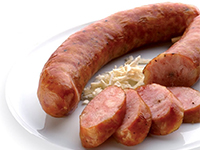
Austrian Krainer. |
The first klobása to discuss is the Austrian Krainer. It comes originally from Slovenia,
where it is called kranjska klobasa. It is common in large parts of Austria and Slovenia.
"Kranjska kelbasa" is a protected trademark in Slovenia, while Krainer and Käsekrainer
are protected in Austria. The Slovenian variety is made of at least 75-80% pork (aside from bacon), and at most 20% bacon.
It may contain as much as 5% water, sea salt from Sečovlje salt flats, garlic, saltpetre and black pepper.
The meat is cut in small pieces 10-13 mm and bacon 8-10 mm. The filling is stuffed into pork-intestine
casing with a diameter of 32 to 36 mm. They come in pairs of 12-16 cm long and a weight of 180-220 grams.
The pairs are linked together with a wooden skewer. The sausages are hot-smoked and heat-cured at about 70° C (158° F).
The Austrian variety is made of at least 68% pork, 12% beef and a maximum 20% fat. The only permitted additives
are 5% water, salt, garlic and pepper. As with the Slovenian version, pork-intestine casing is used.
The finished wurst is 32-36 mm in diameter and 12-16 cm in length and comes in pairs. The pairs are joined together
with a wooden skewer, hot smoked the same way as the Slovenian one.
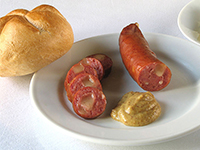
Austrian Käsekrainer (Krainer with cheese). |
Käsekrainer are an Austrian modification of the original recipe in that they contain 10-20% cheese,
such as Emmentaler cut unto in small cubes. They were invented in Austria in 1971.
They can be boiled, fried or grilled. They should not be pierced before cooking, which would
leak the cheese and flavor. Käsekrainer be served with mustard and freshly grated horseradish,
in other variants with mustard and ketchup, optional dusted with curry powder.
Very popular is the Käsekrainer hot dog, in which a Käsekrainer is served in a hollowed-out
piece of white bread with mustard and or ketchup.
Do not confuse the Käsekrainer with the Berner Würstel, which also contains cheese (usually Emmentaler), and is wrapped in bacon.
This sausage does not come from Switzerland, but from the town of Zell am See the Austrian state of Salzburg.
It derives its name from Erich Berne Sr., its inventor, who created it in the 1950s as a
fast food snack for members of the local men's choir.
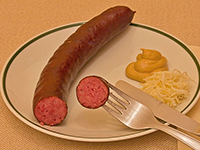
Austrian Waldviertel sausage. |
The Waldviertel is a smoked sausage from the rural part of northern Austria. Waldviertel
means Forest Quarter and is the northwestern region of the Austrian state of Lower Austria.
The sausage is madeof meat and a fixed amount of meat.
It is available in ring or crocheted to shape as the sausage stuffed into a thick skin.
Usually in preparation cooked with mustard and horseradish.
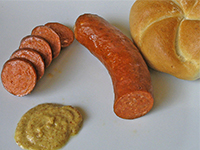
Austrian Burenwurst. |
The Burenwurst is a coarse-grained Brühwurst, available as individual sausages or by the foot.
It is found at almost every wurst stand in Austria, but it is not the most wonderful wurst
under the sun. it is made of about 55% ground meat, 25% lard and the rest are various
salt-cured leftovers the butcher had from the last slaughter.

Kolbász is what sausage is called in Hungary. The sausage-making tradition is very long here.
The dark varieties of Hungarian Kolbász are world-famous and make a great condiment
to go with wine. Here are the best known and most popular varieties.
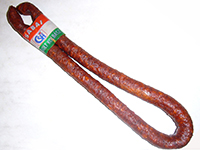
Hungarian Csabai kolbász. |
Csabai kolbász dates back tot he 18th century when it began to be made in the town of Békéscsaba by Slovak settlers.
It is 100% pork (2/3 lean, 1/3 fatty pork belly) from the Hungarian mangalica breed.
The meat is cured with salt and sugar for several days, then ground and seasoned with ground caraway seeds, garlic
and Hungarian paprika (half hot, half sweet). No pepper is used in the traditional Csabai kolbász.
The mixture is stufed into natural pork-intestine casings and cold-smoked over fruit tree fire.
It is traditionally prepared about 20 cm long and dry enough to be broken off by hand.
It is tied with a ribbon in the coliors of the Hungarian flag. It is eaten cold,
with bread and red wine.
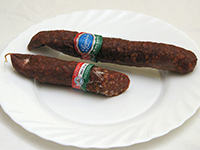
Hungarian Gyulai kolbász. |
Gyulai kolbász is similar in composition to Csabai kolbász but smoked over beech wood and prepared
in straight pieces 18-26 cm long and 26-40 mm in diameter. The finished product has a clean surface,
not moldy, slightly lumpy, reddish brown. The taaste is pleasantly smoky, with a harmoniously spicy fragrance.
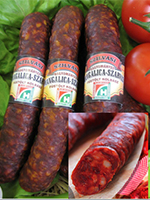 | 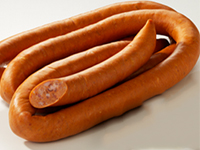 | 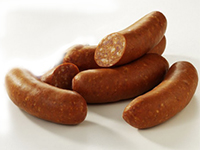 |
| Csemege kolbász. | Lecso kolbász. | Debreceni kolbász. |
Csemege kolbász is an mildly spiced, smoked sausage. Cserkész kolbász is a smoked sausage
made from beef and pork. Debreceni kolbász is usually unsmoked or more mildly smoked,
with a strong paprika flavor and used for cooking. Lecsókolbász, a spicy cooked smoked
sausage made specifically for serving as part of the dish lecsó.

Polish kiełbasa is a pork sausage falling in to the Bruhwurst category, smoked at the end.
The principal varieties include:
- Krakowska kiełbasa: a Brühwurst made from cuts of lean pork, seasoned with pepper, allspice, coriander, and garlic,
packed into large casings, and smoked. It is usually served as a cold cut.
- Wiejska kiełbasa: a 'U' shape Brühwurst, made of pork and veal, seasoned with marjoram,
garlic, salt and pepper, moked at the end. The name means "country-style".
- Kielbasa Mysliwska (hunters' sausage) is made of pork like the Wiejska,
but it usually of better quality. It is a short kiełbasa with a dark brown and wrinkled skin,
divided into pairs, each about 6 in in length. Dark red chunks of beef and bright red pork
are visible in the cross section.
- Biała kiełbasa: a Rohwurst made of raw pork & beef, seasoned with garlic, marjoram, black and white pepper and salt,
stuffed into white natural animal-intestine casing. As it is a rohwurst, this kiełbasa must be cooked
(usually fried) before consumption
- Sląska kiełbasa, kiełbasa toruńska, kiełbasa grilowa, swojska kiełbasa, krajańska kiełbasa,
szynkowa kiełbasa (ham kiełbasa, Schinkenwurst)
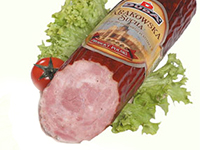 |  |  |
| Kielbasa Krakowska (Krakauer Wurst). | Kielbasa Szynkowa. | Kielbasa Slaska. |
|
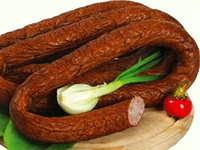 |  |  |
| Kielbasa Wiejska. | Kielbasa Mysliwska. | Kielbasa Biala. |


Czech Špekáček. |
The Czech contribution to the sausage world is the "Špekáček". It it made of finely ground
mixture of pork and beef, with cubes of smoked lard added to it. The name translates as
the "little lard boy". The original recipe, which was first introduced
at the Land Exhibit in Prague in 1891, consists of 50% lean beef, 20% lean pork, and 30% of lard,
seasoned with garlic, pepper and mace. Beef-intestine casing is used,
3-4 cm in diameter, tied with a string to 5-7 cm segments.
The Špekáček is very similar to the Swiss Cervelat. Both are Brühwursts, have similar thickness,
Špekáček is typically divided into short, stubby sausages, while the cervelat is made long, like salami.

Czech weenie roast. |
"Špekáček", due to its high fat content, may not be the healthiest food, but it is the
cornerstone of the recipe for the Czech utopence, špekáčky pickled
in vinegar with onions and peppercorns.
Plus, every Czech kid who has ever roasted weenies around a camp fire has vivid memories
of roasting a špekáček on a stick, everything catching on fire due to the high fat content of the sausage,
the stick burning off, the špekáček falling into the fire, subsequently digging the burned Špekáček out of the ashes....
Therefore, it needs to belong in this list.
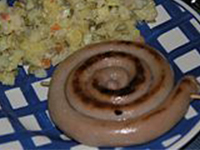
Czech Wine Sausage (vinná klobása). |
Another, and better, Czech klobása is the Wine Sausage (vinná klobása). It is related
to the weisswurst from Bavaria, but this is a Rohwurst
(the Munich weisswurst is a Brühwürst), and to the French boudin blanc.
The Wine Sausage is made from pork and sometimes also veal,
finely ground along with bread rolls soaked in milk, white wine, mace and lemon peel.
Natural animal-intestine casings are used. The sausage sold by the foot or by weight,
rolled into a spiral. As it is too delicate for the grill, it is usually pan-fried,
sometimes coated in bread crumbs.

Pork klobása served on a paper plate with horseradish. |
The last klobása to be discussed is the "Prague street klobása". It is known to anyone, who
has partied late at night in downtown Prague, as the standard late-night repair-food after a party.
Historically, this is a klobása loaded fairly high in fat, but nevertheless a good
antidote after a substantial amount of beer and other booze.
In conclusion, the klobása in general is not up to same level as the Mercedes of
world of wurst, the bratwurst. First, all of the soft varieties of the klobása in general
tend to be more fatty.
When klobása is is put on the grill, even though it has been fully cooked, the skin
has to be cut to allow fat to drain out during the grilling. Obviously, one would never
want to do this to a good quality bratwurst.
Second, if one desires to satisfy his or her primordial instincts and taste
freshly roasted raw meet on open fire, then the German rostbratwurst is the way to go.
There are exceptions, of course. The Czech wine sausage is a delicacy of its own,
finely seasoned and low in fat. Or, most of the dark varieties of Hungarian kolbász make
great condiments for beer and wine. These would stand up on their own in the global
culinary world, but if a good grilling wurst is desired, the bratwurst is king!
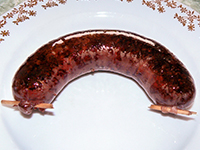
The Czech Grützwurst (jelito). |
What remains to be said? Descending down to the bottom of the world of the pub grub, there
are three more types of Kochwurst that need to be mentioned:
- The German Grützwurst (known in England as the black pudding, and the jelito in the
Czech Republic)
- The Czech jitrnice
- The Czech tlačenka (Presswurst in Germany, hogshead cheese in Louisiana)
The jelito/Grützwurst is made of what is left of the pig during a domestic slaughter.
It contains meat, innards and blood, plus barley or small pieces of bread.
Like jitrnice, the ingredients are the less valuable pieces of the pig: the head, liver,
pork belly, skin, lungs, lard, cracklings, plus fried onions, garlic, salt and spices.
Spices include pepper, marjoram, cumin and allspice.
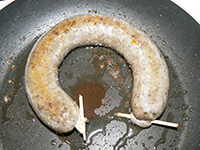
The jitrnice. |
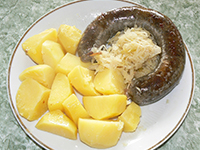
Jitrnice served with
sauerkraut and potatoes. |
The jitrnice is a jelito without the blood. During the preparation,
the jitrnice mixture (Brät) is prepared from partially cooked innards. They are seasoned with garlic,
the raw liver and bread rolls are added and everything is ground. Spices are added.
The Brät is stuffed into pork-intestine casing, making sausages about 20 cm in length.
Then ends are secured with short pieces of wooden skewer.
Once stuffed, the jitrnice are slowly boiled at 85 – 90 °c for 10-15 minutes, until they float up.
Before consumption, they are usually pan-fried and served with bread and beer.
The jitrnice and the jelito are somewhat related to the Scottish haggis. The similarities
are in that both are made from pieces of the animal such as the heart, liver and lungs.
But in case of the haggis, the animal is a sheep and here it is a pig.

The Czech tlačenka (Presswurst). |
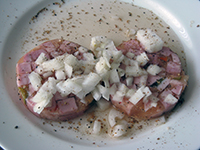
Sliced tlačenka served with
onions, ground pepper and vinegar. |
The last of the last is the tlačenka (Presswurst). It is a large Kochwurst,
made during domestic slaughter from pieces of the pig such as the head, chopped into small pieces,
pickled in gelatine and coagulated tissue. It is usually served in sliced about quarter inch
thick, with white vinegar, raw onion, black pepper, and beer.
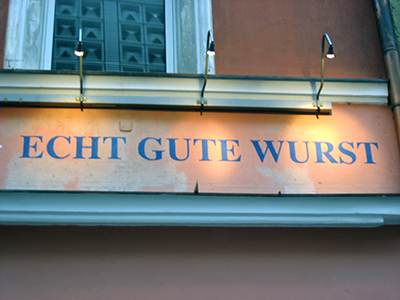
Sources:
- Exhibit "Sousedé na talíři, Die Nachbarn auf dem Teller" held 2011 - August 2011 in Brno, Czech Republic
- Nuernberginfos.de
- Fleischtheke.info
- Tastingpoland.com
- Würstchen.de
- Wurstakademie.com
- Wurst.de
- Wikipedia
back to Radim and Lisa's Well-Travelled Cookbook | email us
Last updated: May 10, 2014
Certain images from Wikimedia Commons, used under the terms of the GNU Free Documentation License.
|





































